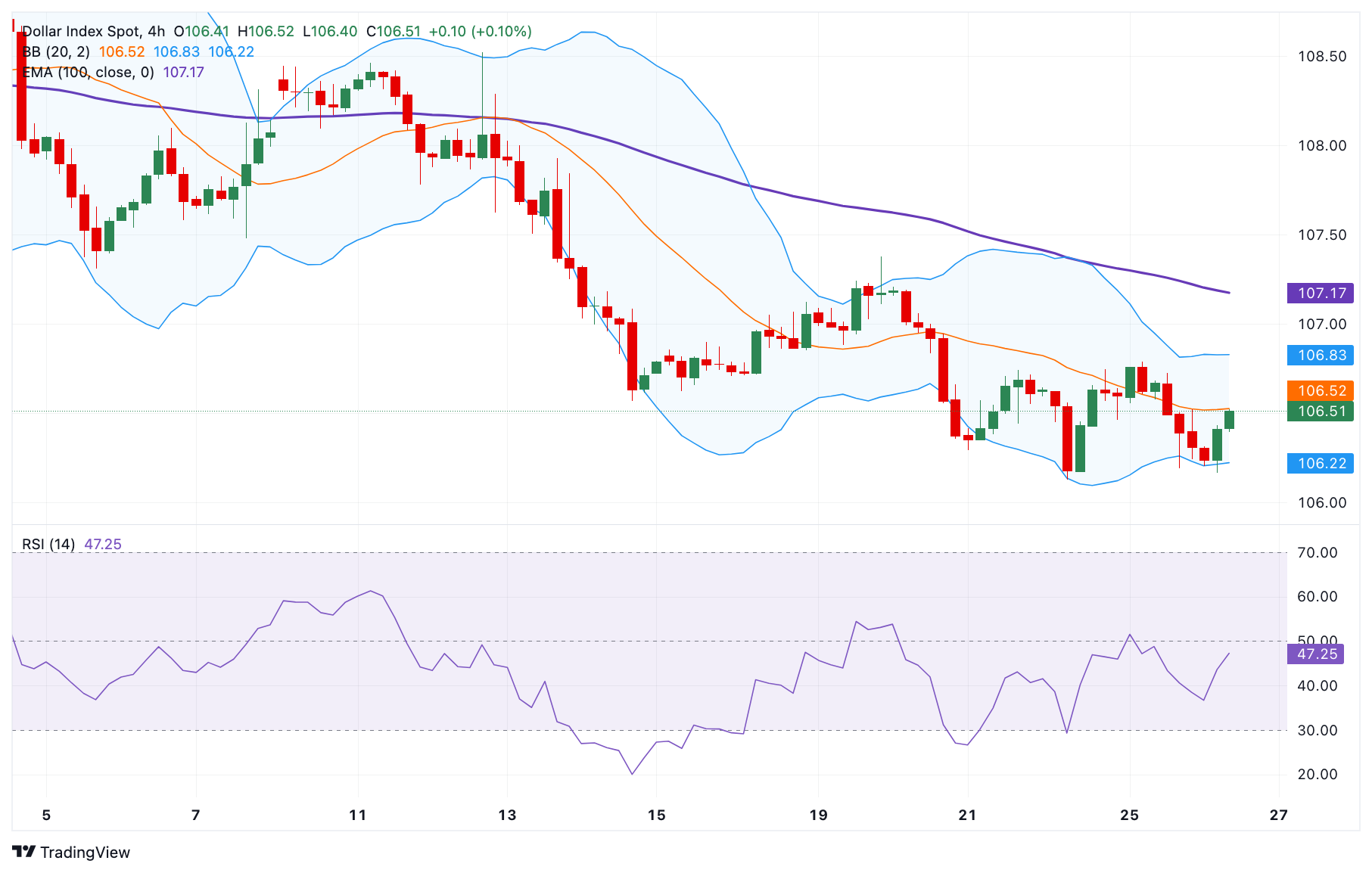- The US Dollar Index recovers to near 106.50 in Wednesday’s early European session.
- The bearish outlook of the DXY remains intact below the 100-period EMA.
- The first downside target to watch is 106.20; the immediate resistance level emerges at 106.85.
The US Dollar Index (DXY) rebounds to around 106.50 during the early European session on Wednesday. Analysts expect that US President Donald Trump’s plans for higher tariffs have raised inflation worries at the US Federal Reserve (Fed), which might lead the Fed to keep interest rates higher for longer. This might support the US Dollar against its rivals.
Investors await the US Personal Consumption Expenditures (PCE) data, the Fed's preferred inflation gauge, on Friday for fresh impetus. This report might offer some hints about the US interest rate path.
Technically, the DXY keeps the bearish vibe on the 4-hour chart as the index remains capped below the key 100-period Exponential Moving Average (EMA). Additionally, the Relative Strength Index (RSI) stands below the 50-midline near 46.40, indicating that further downside cannot be ruled out in the near term.
The lower limit of the Bollinger Band at 106.20 acts as an initial support level for the US Dollar Index. A breach of this level could expose the 105.41, the low of December 6, 2024. The next contention level to watch is 104.19, the low of November 7, 2024.
On the bright side, the first upside barrier is located at 106.85, the upper boundary of the Bollinger Band. Extended gains could pave the way to the 107.15, the 100-period EMA. The next hurdle is seen at the 108.00 psychological level.
US Dollar (DXY) 4-hour chart
US Dollar FAQs
The US Dollar (USD) is the official currency of the United States of America, and the ‘de facto’ currency of a significant number of other countries where it is found in circulation alongside local notes. It is the most heavily traded currency in the world, accounting for over 88% of all global foreign exchange turnover, or an average of $6.6 trillion in transactions per day, according to data from 2022. Following the second world war, the USD took over from the British Pound as the world’s reserve currency. For most of its history, the US Dollar was backed by Gold, until the Bretton Woods Agreement in 1971 when the Gold Standard went away.
The most important single factor impacting on the value of the US Dollar is monetary policy, which is shaped by the Federal Reserve (Fed). The Fed has two mandates: to achieve price stability (control inflation) and foster full employment. Its primary tool to achieve these two goals is by adjusting interest rates. When prices are rising too quickly and inflation is above the Fed’s 2% target, the Fed will raise rates, which helps the USD value. When inflation falls below 2% or the Unemployment Rate is too high, the Fed may lower interest rates, which weighs on the Greenback.
In extreme situations, the Federal Reserve can also print more Dollars and enact quantitative easing (QE). QE is the process by which the Fed substantially increases the flow of credit in a stuck financial system. It is a non-standard policy measure used when credit has dried up because banks will not lend to each other (out of the fear of counterparty default). It is a last resort when simply lowering interest rates is unlikely to achieve the necessary result. It was the Fed’s weapon of choice to combat the credit crunch that occurred during the Great Financial Crisis in 2008. It involves the Fed printing more Dollars and using them to buy US government bonds predominantly from financial institutions. QE usually leads to a weaker US Dollar.
Quantitative tightening (QT) is the reverse process whereby the Federal Reserve stops buying bonds from financial institutions and does not reinvest the principal from the bonds it holds maturing in new purchases. It is usually positive for the US Dollar.
Information on these pages contains forward-looking statements that involve risks and uncertainties. Markets and instruments profiled on this page are for informational purposes only and should not in any way come across as a recommendation to buy or sell in these assets. You should do your own thorough research before making any investment decisions. FXStreet does not in any way guarantee that this information is free from mistakes, errors, or material misstatements. It also does not guarantee that this information is of a timely nature. Investing in Open Markets involves a great deal of risk, including the loss of all or a portion of your investment, as well as emotional distress. All risks, losses and costs associated with investing, including total loss of principal, are your responsibility. The views and opinions expressed in this article are those of the authors and do not necessarily reflect the official policy or position of FXStreet nor its advertisers. The author will not be held responsible for information that is found at the end of links posted on this page.
If not otherwise explicitly mentioned in the body of the article, at the time of writing, the author has no position in any stock mentioned in this article and no business relationship with any company mentioned. The author has not received compensation for writing this article, other than from FXStreet.
FXStreet and the author do not provide personalized recommendations. The author makes no representations as to the accuracy, completeness, or suitability of this information. FXStreet and the author will not be liable for any errors, omissions or any losses, injuries or damages arising from this information and its display or use. Errors and omissions excepted.
The author and FXStreet are not registered investment advisors and nothing in this article is intended to be investment advice.
Recommended content
Editors’ Picks

EUR/USD jumps back above 1.1000 on renewed US Dollar sell-off
EUR/USD is posting sizeable gains above 1.1000 in early Europe on Monday. EU prepares for retaliatory tariffs and rekindles the global trade war and US recession fears, drowning the US Dollar again aross the board. Traders now look to the EU Sentix and Retail Sales data.

GBP/USD holds recovery gains above 1.2900 amid fresh US Dollar weakness
GBP/USD clings to recovery gains above 1.2900 in European trading on Monday. The pair capitalizes on renewed US Dollar weakness as risk sentiment takes a fresh hit, with European traders hitting their desks. Trump's tariffs-led US recession fears and dovish Fed bets keep the USD undermined.

Gold price rebounds swiftly from multi-week low; lacks follow-through
Gold price reverses an Asian session slide to over a three-week low, though it lacks follow-through. Recession fears continue to weigh on investor sentiment and benefit the safe-haven commodity. Bets for more aggressive Fed rate cuts undermine USD and also lend support to the XAU/USD pair.

Crypto market wipes out $1 billion in liquidation as Asian markets bleed red
The crypto markets continue to decline on Monday, with Bitcoin falling below $78,000. The Asian markets also traded in the red, with Japan’s stock market extending losses to 8.5%, its lowest level since October 2023.

Strategic implications of “Liberation Day”
Liberation Day in the United States came with extremely protectionist and inward-looking tariff policy aimed at just about all U.S. trading partners. In this report, we outline some of the more strategic implications of Liberation Day and developments we will be paying close attention to going forward.

The Best brokers to trade EUR/USD
SPONSORED Discover the top brokers for trading EUR/USD in 2025. Our list features brokers with competitive spreads, fast execution, and powerful platforms. Whether you're a beginner or an expert, find the right partner to navigate the dynamic Forex market.




